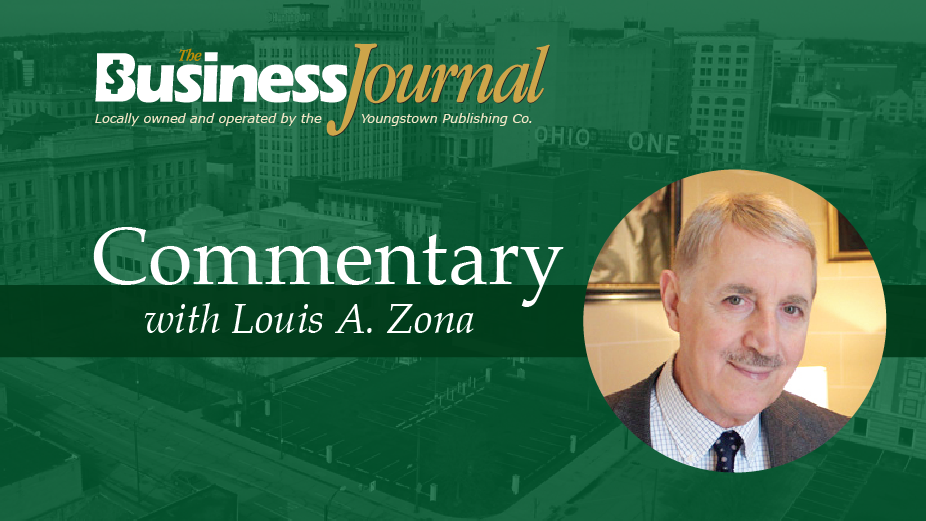By Louis A. Zona
YOUNGSTOWN, Ohio – I have been teaching about art for a very long time. Despite the years in the classroom, attempting to accurately define art becomes a mystery tour.
I’ve come to the conclusion that the dictionary definition that states “art is the creation of beautiful or thought provoking things” may be right or may be very wrong.
That definition is fine just as long as we know what the word beautiful means. I read somewhere that President Johnson once said that if we all knew what constitutes beauty, we’d all have the same wife. I don’t know about that.
But I do think that the artist Ad Reinhardt probably had the very best definition. “Art is art. Everything else is everything else.”
Given the current state of art, when a banana taped to the wall is called art, it appears as if most anything goes.
The famous anti-establishment artist Marcel Duchamp took it a step farther when he said, “Anything that an artist says is art is art.” That is simple enough and in the end probably the most useful definition, even for party small talk.
You see what I’m getting at. It is as difficult to define as that definition of obscenity that the Supreme Court grappled with. Justice Potter Stewart ended the debate by saying, ”I know it when I see it.”
I would guess that we could adapt Stewart’s answer to a definition of pornography to art. We might say that we’ll know if it’s art when we see it.
Sometimes our eyes deceive us, however, when we ask ourselves if that really is a banana on the wall, and more important, what is a banana doing on the wall of an art gallery? I hope no one slips on it if it is jarred loose.
With that said, I would add that a banana on the wall, as far as I’m concerned, is not art. The rest of the story on the so-called banana artwork is that a fellow grabbed the banana, peeled it and ate it in front of a laughing crowd.
The price of this precious piece of art was $120,000.
I would guess that the artist then drove to the nearest Albertsons and purchased another banana.
But what if I go to see it and declare that it is not art and not even an organic banana. Who knows, there might be a hungry monkey in the crowd just imagining how tasty that yellow artwork might be.
I probably should be a little more tolerant of what we might term “new art.” I’m sorry; it looked like a quickly ripening banana to me and probably to the monkey as well.
As far as the culprit who ate the first installation is concerned, he should have to do community service in his favorite produce department.
Speaking of monkeys, you might remember that a television program in the 1950s featured a monkey actually painting. So the host of that program asked the serious question: Is the monkey painting art?
Should we take it seriously? After all, one or two of his paintings might even have been sold to a collector of abstract art. I doubt that the monkey artist had art on its mind instead of a nice yellow banana. If the monkey doesn’t know he is creating art, then he is not creating art.
It is something like the tree in the forest. This would go back to Marcel Duchamp’s definition of art being anything that an artist says is art, is art.
So I’ve taken sides in the definition debate by assuming that the monkey has not a clue as to what he is doing. Art … what’s that? Let’s eat! I thought I saw a banana on the wall over there and it looks wonderfully delicious.
Frankly, so-called artists become charlatans when they believe that when it comes to art, anything goes. What this silliness does is to trivialize serious art and artists.
Just because a “Believe It or Not” television program tricks people into thinking that a painting the swinging tail of a donkey created was made by a serious abstract painter doesn’t make it so. Anyone with decent eyesight and a good brain can tell the difference.
Wassily Kandinsky first devised abstract painting in 1910. It was a breakthrough back then and continues to be a very serious mode of painting.
Just as music without words is considered to be music, the same can be said for the visual arts. Lines, shapes, colors and textures formed in the human eye and mind, without a storyline attached, is every bit a work of art as a spring landscape or a still life with bottles and fruit.
Another way to look at it is to realize that to make something from nothing is much harder than to paint the landscape before you.
Duchamp, an artist of the early 20th century, believed that art could be discovered in found objects from a snow shovel to a urinal. That’s right, a bathroom fixture the artist found was proclaimed to be a work of art and titled “The Fountain.” It can be found in most art history texts.
I am sure that Duchamp probably inspired that banana on the wall. I apologize to that monkey who would have enjoyed a nice ripe banana instead of some porcelain hardware next to a makeshift sign that reads, ”Don’t forget to flush the artwork.”
